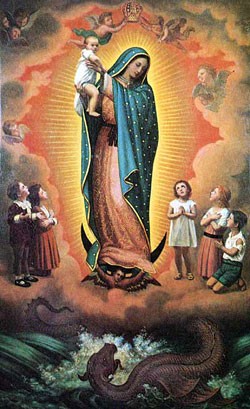Our Lady of Guadalupe
Our Lady of Guadalupe -Neustra Senora de Guadalupe -Virgin of Guadalupe
National symbol of Mexico – Patroness of the Americas
National symbol of Mexico – Patroness of the Americas
The Virgin Mary appeared before Juan Diego in a vision in December 1531. She holds a special place in the religious life of Mexico and is one of the most popular religious devotions. Popes through the ages have recognized Our Lady of Guadalupe. Pope John XXIII was the first to call the Mother of the Americas on October 12, 1961. John Paul II was the first The Catholic Church remains firmly entrenched in Mexico, Central and South America, which today are at least 90% Catholic.
Today, Our Lady of Guadalupe continues to inspire millions. Her shrine in Mexico City is one of the most visited shrines in the world. It has existed on site since at least 1556 when the archbishop of New Spain promoted devotion to the image of Mary in the chapel at Tepeyac.
Our Lady of Guadalupe’s role is not limited to religious matters. She is an important symbol of Mexican nationalism and identity. The great floods of 1629 took 30,000 lives. The waters stopped when the image of the Lady was taken in procession from Tepeyac to Mexico City. In the 1700’s a plague took the lives of 700,00 people. On April 27, 1737, the Virgin was declared the Patroness of Mexico and the disease dissipated. The image of the Virgin appeared on the rebels’ banners during the 1810 revolt against Spain. The rebels’ battle cry was “Long Live Our Lady of Guadalupe.” Her image also appeared on the banners of rebels during the civil war in 1926-29. The thousands of pilgrims that visit her shrine every year declare her significance.
There is much debate over the original name given to the apparition. According to the earliest account of the apparition, the Nican Mopohua, written in the Nahuatl language around 1556, the Virgin Mary told Juan Bernadino that the image left on the tilma was to be known by the name "the Perfect Virgin, Holy Mary of Guadalupe." In 1675, more than a hundred years later, Luis Becerra Tanco suggested that the Spanish must have misunderstood Juan Bernardino and Juan Diego, and proposed two alternatives in Nahuatl that sound similar to "Guadalupe". They mean "she whose origins were in the rocky summit" and "she who banishes those who devoured us." Becerra Tanco based his argument on the fact that the "g" and "d" sounds do not exist in Nahuatl. Arguments in favor of the original name "Guadalupe" include the fact that Juan Diego and Juan Bernardino would have had to be familiar with the "g" and "d" sounds to pronounce their baptismal names. Also, there is no evidence to show that the Virgin was called anything else.
Today, Our Lady of Guadalupe continues to inspire millions. Her shrine in Mexico City is one of the most visited shrines in the world. It has existed on site since at least 1556 when the archbishop of New Spain promoted devotion to the image of Mary in the chapel at Tepeyac.
Our Lady of Guadalupe’s role is not limited to religious matters. She is an important symbol of Mexican nationalism and identity. The great floods of 1629 took 30,000 lives. The waters stopped when the image of the Lady was taken in procession from Tepeyac to Mexico City. In the 1700’s a plague took the lives of 700,00 people. On April 27, 1737, the Virgin was declared the Patroness of Mexico and the disease dissipated. The image of the Virgin appeared on the rebels’ banners during the 1810 revolt against Spain. The rebels’ battle cry was “Long Live Our Lady of Guadalupe.” Her image also appeared on the banners of rebels during the civil war in 1926-29. The thousands of pilgrims that visit her shrine every year declare her significance.
There is much debate over the original name given to the apparition. According to the earliest account of the apparition, the Nican Mopohua, written in the Nahuatl language around 1556, the Virgin Mary told Juan Bernadino that the image left on the tilma was to be known by the name "the Perfect Virgin, Holy Mary of Guadalupe." In 1675, more than a hundred years later, Luis Becerra Tanco suggested that the Spanish must have misunderstood Juan Bernardino and Juan Diego, and proposed two alternatives in Nahuatl that sound similar to "Guadalupe". They mean "she whose origins were in the rocky summit" and "she who banishes those who devoured us." Becerra Tanco based his argument on the fact that the "g" and "d" sounds do not exist in Nahuatl. Arguments in favor of the original name "Guadalupe" include the fact that Juan Diego and Juan Bernardino would have had to be familiar with the "g" and "d" sounds to pronounce their baptismal names. Also, there is no evidence to show that the Virgin was called anything else.

